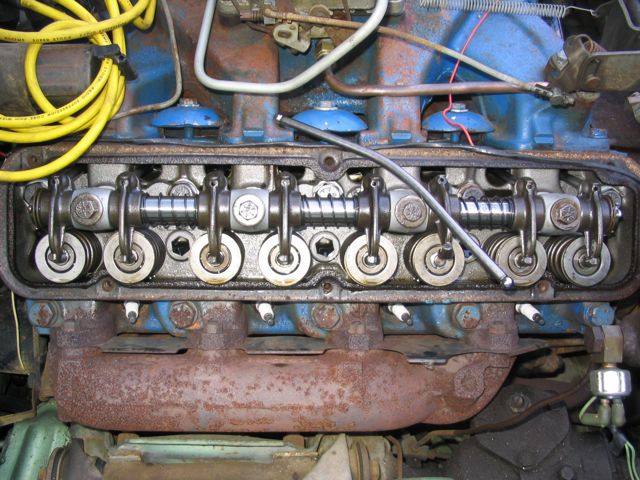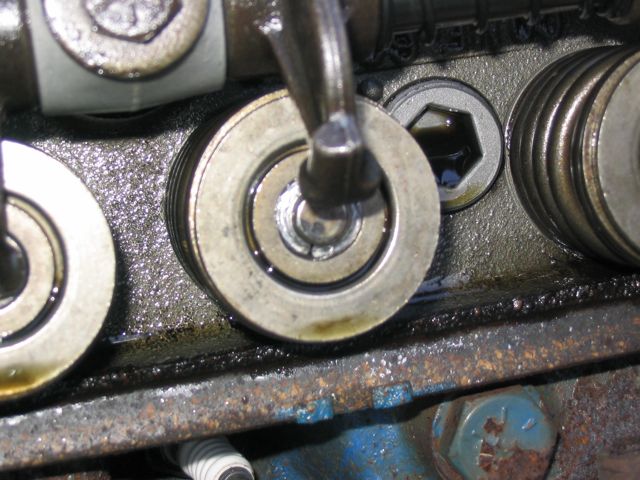Over the next year, I fixed things that were easy to do and didn’t put the car out of use. At this point I wasn’t contemplating a complete restoration.
Engine Noises
The engine seemed to run well, but the clicking noise needed investigation. After pulling the valve covers, here is what I found:


A stuck lifter had bent the pushrod. Amazing how well it ran on 7 cylinders! The valve stem keeper was also galled and smashed. After replacing the lifter, pushrod and carefully replacing the valve stem keeper, we were back hitting on all 8.
Tech note: To replace the valve stem keeper without pulling the head, pressurize the cylinder with 100 psi air to keep the valve from dropping, and then compress the valve spring.
Saga of the electric fuel pump
The mechanical fuel pump had been removed and replaced with an electric pump. A homemade blocking plate covered the spot on the timing cover where the mechanical pump would go. To restore the original setup, I removed the electric pump and installed a NOS mechanical pump. Now it should be back to stock… except there was no fuel getting into the carb.
Checking the pump showed it to be OK, but I found that the arm on the pump wasn’t moving. On the 430, there is an eccentric on the end of the camshaft which engages on a pushrod that moves the fuel pump arm. Apparently the pushrod was too short and wasn’t moving the fuel pump arm.
More research showed that the 1960 Lincoln 430 used a brass-tipped fuel pump pushrod. I was able to find one on EBay, and after installing it, I was sure the fuel would flow. The engine started up and ran fine on the mechanical pump – for about 5 minutes! As it turned out, the brass tip on my brand new fuel pump pushrod had been worn down to nothing.
I was beginning to see why the former owners had installed an electric pump. What was wearing down the pushrod? I rigged a light and magnifier to peer down into the timing cover and look at the fuel pump eccentric. What I found was the surface of the eccentric was galled and cratered. That is what wore down my new pushrod. To replace the eccentric, would require pulling the timing cover – a task for a later date. So the electric pump went back in place for now.
Tech note: Different years of the 430 used different versions of the fuel pump pushrod.
1958-1963 430CID up to 01 Jan 1963 4.875 inches
1963-1965 430CID after 01 Jan 1963 4.812 inches
1966-1967 462CID 4.812 inches
The measurement of 4.875 is correct for the 59-60 430. The diameter is 3/8"
From Ford Master Parts Books:

Heater Box Leaks
Another problem solved – coolant leaked out of the heater box onto the floor. I found that the heater control valve was in bad shape. As it turns out, the original heater control valve has a fluid-filled tube which thermostatically controls the valve (see excerpt from Ford Master Parts Book below).

This type of valve is apparently unobtainable as a replacement part. The typical replacement has a mechanical valve inserted in the heater hose on the engine side of the firewall. A Bowden cable controls it from the heater control head on the console. Unfortunately, it is not a stock appearance but apparently this replacement type valve was used by Ford for many years.

Steering Wheel Restoration
Yes, you can restore your cracked, flaky steering wheel. Eastwood makes a kit for this which basically consists of epoxy to fill the cracks and primer. After hours of filling, sanding, more filling and more sanding, you can paint the wheel. I made a “turntable” of sorts to spin the wheel while I painted it with Antique White Krylon enamel. After about 5 coats, it looked great!
As fate would have it, about a week after restoring the wheel, I met a guy parting out his 1960 and picked up an unrestored steering wheel in excellent condition, among other parts.